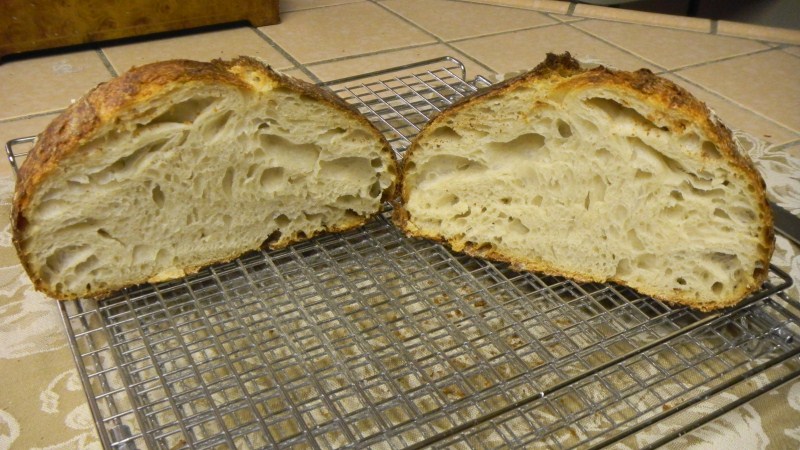Hello,
I wanted to try out a schedule that worked for my normal work-week and maximizing
flavor, because I am usually not around during the daytime hours. Also I
wanted to see the effect of a purely white flour mash.
Due to the way my schedule works, I did bulk ferment of 24 hrs, with the understanding
that my final dough might be sour (hopefully not inedible sour),
So for this recipe I was going for 100% white flour. For my palette, a white
bread with a solid tang is good. Maybe not so much tang for breads with a high
percentage of whole grains.
Turns out, this was perfect (for me). I would make this again. Tastes great!
All flour is KA Bread Flour, except for the starter flour which is KA AP.
All weight in grams.
Total Dough Weight: 1000
Total Dough Hydration: 68%
Total Dough Flour Weight: 595
Total Dough Water Weight: 405
Percentages:
Levain Percentage: 20%
Levain Hydration: 125%
Starter Percentage: 10% of leaven
Starter Hydration: 125%
Soaker Percentage: 54%
Soaker Hydration: 80%
Mash Percentage: 20% of soaker
Mash Hydration: 200%
Soaker Salt Percentage: 1%
Overall Dough Salt Percentage: 1.5%
Levain:
Flour Weight: 114
Water Weight: 143
Starter Weight: 12
Mash:
Flour Weight: 64
Water Weight: 128
Diatastic Malt Powder: 1
Soaker:
All Mash:
Flour Weight: 257
Water Weight: 129
Salt Weight: 3
Final Dough:
All Levain
All Soaker/Mash
Flour Weight: 155
Salt: 6
Procedure I did:
1) Evening #1, made mash. I did 55C for 90 mins, 60C for 30 mins,
65C for 30 mins, 70C for 30 mins.
2) Morning #2, mixed levain and soaker/mash.
3) Evening #2, mixed everything to final dough. Put dough into
chiller at 44F / 6.6C.
4) Morning #3, stretch + fold.
5) Evening #3, took dough out of chiller, another stretch + fold.
6) Final of evening #3:
Allowed 1 hr for warm-up.
Shaped. Cut out a small chunk of dough to watch bubble activity.
It took 2.5 hours for dough to be ready for bake -- Both from bubble activity
and feel of the dough. I am getting better at gauging the feel of the dough,
and not needing the crutch of watching bubble activity, but it is good to have
the small chunk of dough as a confirmation.
Turns out, I am still staying up too late on Evening #3, because it takes a while
for the dough to do the final ferment after being the chiller for so long.
But, I can make bread during the week! :)
Pictures:
Oven after first 10 minutes of steam:

Baked with steam (above) for 10 mins at 460F, then lowered to 420F. Here it is after 20 mins at 420F.

A little bit darker than I'd like, but all good. Internal temp measured 207F and was hollow to the thump.


Crumb:



Happy baking!